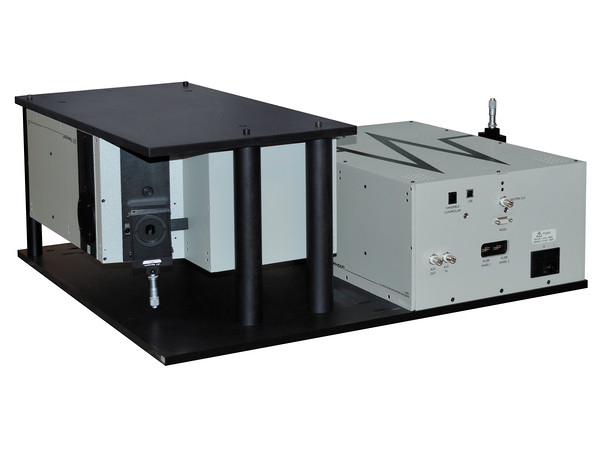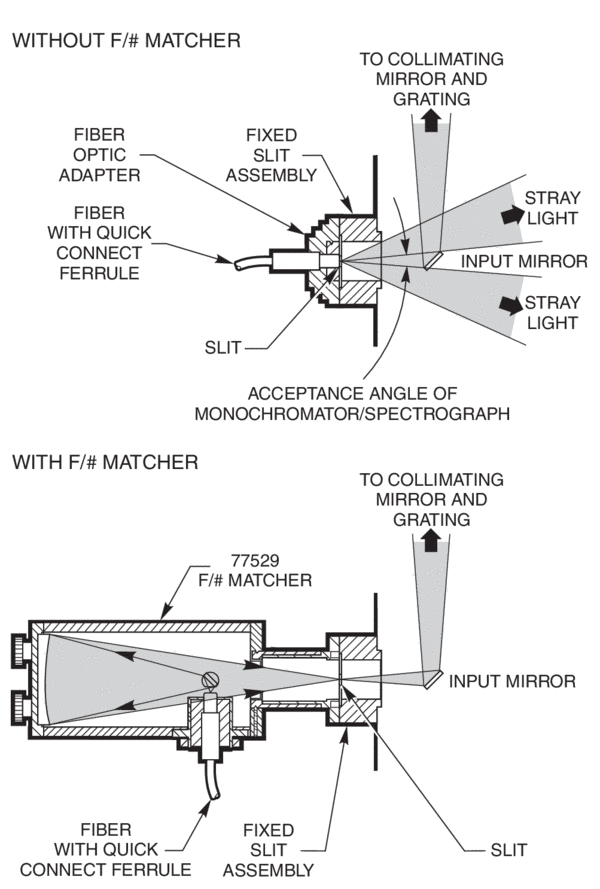Stray light may have a variety of origins. Its presence may be caused by a wide variety of design and manufacturing factors. The level of stray light due to the dispersed radiation inside a monochromator or spectrograph is affected by the design of the instrument, its baffles and interior finish.
Usually, part of this unwanted light, called re-entrant spectra, is due to diffracted light being directed onto the entrance, collimating or focusing mirror, and then back towards the grating. Light can also be reflected off a focal plane detector such as a diode array back into a spectrograph and similarly cause re-entrant spectra.
The output of most fiber optics, characterized by the fiber F/#, is too divergent for efficient acceptance by a monochromator or spectrograph. This leads to potentially significant loss in efficiency and increased stray light due to the overspill of the beam inside the instrument
In a spectrograph / detector array system, stray light can be a more significant problem than it is with scanning monochromators. The array is a much larger target for stray radiation; there is no exit slit to limit the field of view for the detector. Some signal is reflected back off the array where it is scattered as stray light, and the array itself typically has less dynamic range than single element detectors.
It is difficult to characterize the stray light behavior of spectrographs. As with monochromators, variation in spectral content of your source, grating choice, and type of signal, contribute to stray light. The structure and choice of array, wavelength region, and internal specular reflections add to this changing picture for spectrographs.
All Oriel Spectrographs are designed for low stray light. The Oriel MS260i™, MS125 and MS257™ spectrographs conform to design rules that eliminate re-entrant spectra. Re-entrant spectra are due to diffracted radiation being reflected off the detector or one of the mirrors, back to the grating, where it is diffracted again and then focused onto the array. Without proper elimination of stray light, ghost spectral lines appear, disappear and move when the wavelength changes.
Oriel monochromators and spectrographs are designed to minimize stray light. The Ebert-Fastie out of plane design used in the model 77250 monochromator has no re-entrant spectra, and neither does the model 77781 MS257 monochromator. Re-entrant spectra are absorbed on baffles and by tilting the detector in the MS125 spectrograph.
The grating used and the operating wavelength are additional contributors to stray light. Oriel uses low stray light gratings mounted to black, low reflectance mounts. Stray light also depends strongly on such external factors as the intensity and spectral distribution of the input source and detector's spectral response.
To further minimize stray light, the following suggestions may be implemented:
- Use an integrating sphere to uniformly illuminate the spectrograph or monochromator input.
- If an integrating sphere is not used, place the light source at normal incidence to the instrument's input.
- Match the f/# of the light source to the spectrograph or monochromator F/#.
- If using fiber optics, utilize the Oriel 77529 F/# Matcher.
- For a major improvement in the signal to stray light ratio, use a double MS257 monochromator.
 Over 8,000 products in-stock! & FREE 2-Day shipping on all web orders!* Learn More FREE T-Shirt with orders $250+ Details
Over 8,000 products in-stock! & FREE 2-Day shipping on all web orders!* Learn More FREE T-Shirt with orders $250+ Details

 Ultra-High Velocity
Ultra-High Velocity